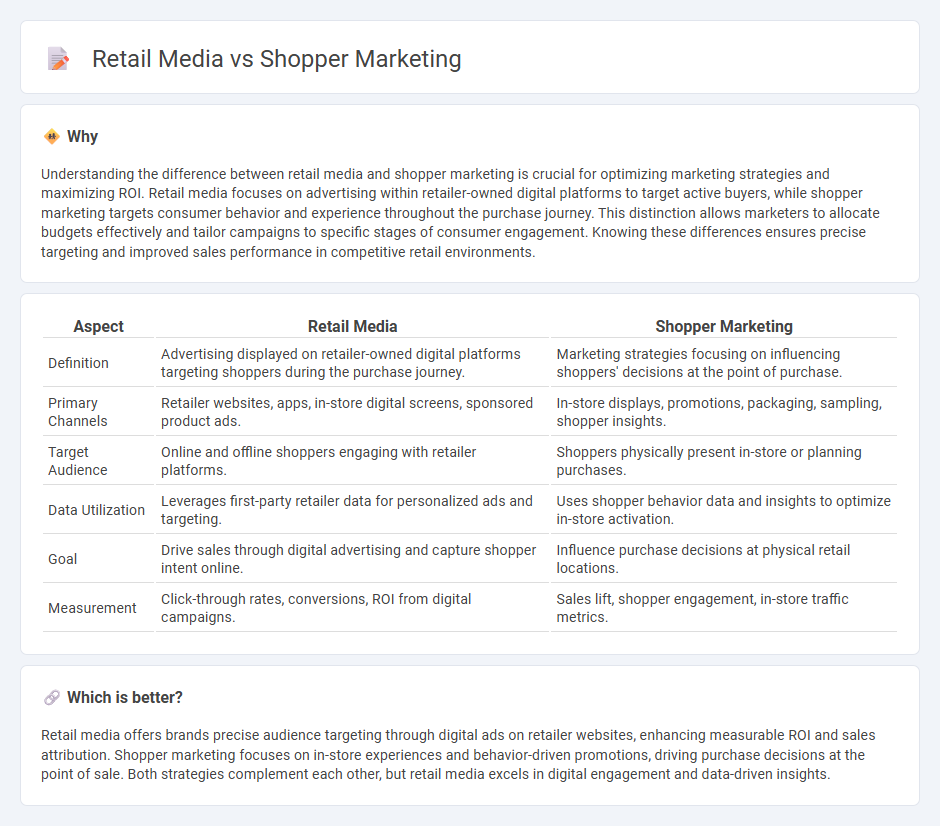
Retail media leverages digital advertising within retail environments to target consumers at the point of purchase, utilizing data-driven insights to enhance ad relevance and shopper engagement. Shopper marketing focuses on understanding consumer behavior in-store and online to influence purchasing decisions through tailored promotions, product placement, and experiential strategies. Discover how integrating retail media and shopper marketing can boost brand visibility and drive sales growth.
Why it is important
Understanding the difference between retail media and shopper marketing is crucial for optimizing marketing strategies and maximizing ROI. Retail media focuses on advertising within retailer-owned digital platforms to target active buyers, while shopper marketing targets consumer behavior and experience throughout the purchase journey. This distinction allows marketers to allocate budgets effectively and tailor campaigns to specific stages of consumer engagement. Knowing these differences ensures precise targeting and improved sales performance in competitive retail environments.
Comparison Table
| Aspect | Retail Media | Shopper Marketing |
|---|---|---|
| Definition | Advertising displayed on retailer-owned digital platforms targeting shoppers during the purchase journey. | Marketing strategies focusing on influencing shoppers' decisions at the point of purchase. |
| Primary Channels | Retailer websites, apps, in-store digital screens, sponsored product ads. | In-store displays, promotions, packaging, sampling, shopper insights. |
| Target Audience | Online and offline shoppers engaging with retailer platforms. | Shoppers physically present in-store or planning purchases. |
| Data Utilization | Leverages first-party retailer data for personalized ads and targeting. | Uses shopper behavior data and insights to optimize in-store activation. |
| Goal | Drive sales through digital advertising and capture shopper intent online. | Influence purchase decisions at physical retail locations. |
| Measurement | Click-through rates, conversions, ROI from digital campaigns. | Sales lift, shopper engagement, in-store traffic metrics. |
Which is better?
Retail media offers brands precise audience targeting through digital ads on retailer websites, enhancing measurable ROI and sales attribution. Shopper marketing focuses on in-store experiences and behavior-driven promotions, driving purchase decisions at the point of sale. Both strategies complement each other, but retail media excels in digital engagement and data-driven insights.
Connection
Retail media leverages shopper marketing insights to target consumers with personalized advertisements at crucial points in the purchasing journey. By integrating shopper behavior data and preferences, retail media campaigns enhance engagement and drive conversion rates within retail environments. This synergy allows brands to optimize advertising spend while delivering relevant messaging that influences in-store and online buying decisions.
Key Terms
Shopper Marketing:
Shopper marketing targets consumer behavior at the point of purchase, using insights to influence decision-making through in-store promotions, product placements, and personalized messaging. It leverages data on shopper habits and preferences to create tailored experiences, driving conversion rates and brand loyalty directly in retail environments. Discover how integrating shopper marketing strategies can enhance engagement and boost sales effectiveness.
Path to Purchase
Shopper marketing targets consumer behaviors and motivations at every touchpoint along the path to purchase, leveraging personalized experiences to influence buying decisions directly in-store or online. Retail media focuses on data-driven advertising within retailer platforms, maximizing ad spend effectiveness by reaching consumers with relevant promotions during their shopping journey. Discover how integrating shopper marketing and retail media strategies can optimize the path to purchase for increased sales and customer engagement.
In-Store Activation
Shopper marketing centers on in-store activation strategies designed to influence purchase behavior at the point of sale through product displays, sampling, and interactive experiences. Retail media leverages digital advertising within retail environments, targeting consumers with tailored promotions on platforms like retailer websites, apps, and in-store digital screens. Explore effective in-store activation methods to enhance brand engagement and drive sales conversion.
Source and External Links
What Is Shopper Marketing? Definition and Tactics (2024) - Shopper marketing is a strategy that uses behavioral insights to influence consumer purchasing decisions at key points in their journey, turning browsing into buying through tactics like in-store displays and personalized ecommerce ads.
Shopper Marketing: Key Principles and Real-World Examples - Shopper marketing drives sales by engaging consumers at purchase points with tactics such as eye-catching displays and demos, while fostering crucial brand-retailer collaboration for mutual success.
Shopper Marketing Strategy: A Guide for CPG Brands - An effective shopper marketing strategy creates a triple win for brand, shopper, and retailer by understanding shopper behavior, capturing interest, incentivizing purchases, and aligning with retailer goals to drive demand and conversion.
 dowidth.com
dowidth.com